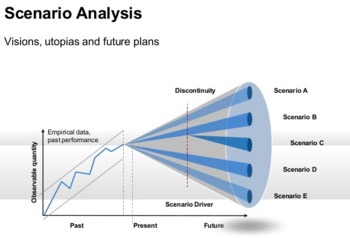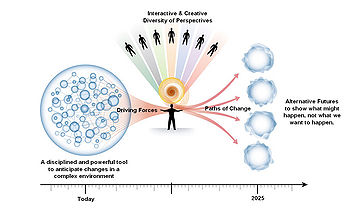Scenario Planning Strategy
Scenario Planning Strategy is a systematic and methodical way for organisations to define their future actions. It is considered as part of the Strategic management tools, aiming to create a flexible plan, based on which the organisation will benefit in the long term. Scenario planning came to change and enhance the way of thinking in terms of decision making under critical uncertain cirumstances. According to Pierre Wack "Scenarios deal with two worlds; the world of facts and the world of perceptions" [1]. The known and the unknown are mixed and a set of different possible scenarios for a particular issue is formed following people's both subjective and objective thoughts regarding how the social, technical, economic, environmental and political (STEEP) trends are going to affect it. The holistic integrated pictures of the future assist companies to both quantify and qualify their future policies and strategies creating an adaptable planning that mitigates the possible negative impacts on them.
Different types of scenarios exists depending on the specific case [2] . There are also different approaches and steps for utilizing scenario planning in businesses. Nowadays, a common thread to identify your possible scenarios is to implement a SWOT analysis or PEST Analysis having in mind the pace of which changes happen in the buisness sector, increasing business critical uncertainties. Although, as in every management tool there are limitations and weaknesses that managers and businesses should take into account and will be analyzed in the article as well. A specific focus will be made in scenario planning and its liaison with project porgram and portfolio management. The article aims to investigate in what extend this tool can be implemented and what is the process to succeed it. A general overview of scenarios development and the Project program and Portfolio Management context will be presented in order to identify their incorporation.
Contents |
Big Idea
Origin of Scenarios
The first time that scenario planning came into view as a concept was during the Second World War as a technique for military planning, trying to conceive and prepare against, the opponents' actions [2]. The years after, the concept further developed in military intelligence focusing on policy games where different parties involved, were playing different roles under multiple plausible stories, with the view to observe the reaction of persons under different uncertain circumstances. Later, during 1970s, scenario planning revolutionized business sector with its application in Royal Duch Shell. Pierre Wack, was the first who was looking for possible strategies in case an unexpected event is occurred in the Oil market. Through his scenarios, he facilitated the managers of the company to imagine their decision in case each of this scenarios was taken place [2]. When the oil crises broke out in 1973 no one was expecting it and only Shell was effectively prepared to address the issue. A widespread acceptance and an increase in the tools appeal was further reinforced after the terrorist attack in September 11th 2001 in the US [1]. The attack was one of the most tangible examples of the high uncertainties that occur in 21st century along with its tremendous impacts.
Context
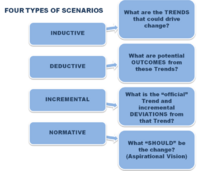
Scenarios
Scenario planning it is not about predicting the most likely future; it is about addressing assorted sets of strategic buisness issues by rehearsing different decisions based on a range of possibilities [4]. Different kind of scenarios exist that is hard to sort them. The categorization of the scenarios, facilitates the communication, comprehension, comparison and further development of the concept [5]. Nonetheless, a consensus hasn't been reached yet and a standardization hasn't been attempted. Examples are presented in Figures 1, 2 and 3 that show three common approaches of scenario typologies according to the angle and the variants that each one has been developed.
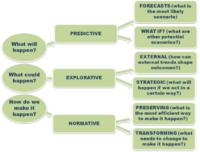
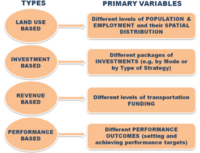
Several approaches have been developed in a theoretical point of view pertaining the creation of scenarios. In practise, each organization choose their own strategy and key principles for a good scenario formation. A general guidance for a successful scenario creation is summarized below [6]:
- The plausibility of scenarios and the rational consistency with the known facts is the first key principle. Apart from being interesting they should be also challenging in respect to organizatios' criteria. It worth to note that even if a wide range of possible scenarios will be determined for a particular issue, as a group should be mutual exclusive and concise.
- During the implementation of scenario planning process, organizations should have the consciousness and insight comprehension that divergence and not convergence drives the industries. Their envisage of the future should crearly shows that.
- Scenarios should not be limited in worst or best-case scenario. Setting constrains is like trying to set boundaries to the evolution of nature. In life, there is not only bad or good perspective, there is also a huge prospect between them. As a result creativity and imagination should play a vital role in the process considering both major changes such as, an extensive economic crisis, recession, natural disaster etc and smaller scale changes.
- The number of the possible scenarios is a matter of interest. Preferably, a description of more than three but less than five scenarios should be developed. This number let the managers to easier handle them without covering only the basic probabilities of worst case, best case and most likely futures.
Project Program and Portfolio Management
Portfolio Management consists of a set of principles and processes that aim to implement and coordinate a group of projects or programs. Portfolio defines the strategy while the management of portfolio creates priorities and ensures the alignment of the projects. It is an investment that in order to be successful, money, man, machines and materials should effectively be managed. According to Cooper et al, portfolio management is "… a dynamic decision process whereby a business’ list of projects is constantly updated and revised. New projects are evaluated, selected, and prioritized; existing projects may be accelerated, killed, or deprioritized; and resources are allocated and reallocated to active projects" Although, nowadays decision making becomes more and more complex as a number of influences should be taken into account [6]. Furthermore, in the already vulnerable environment of social, political, economical, technological and environmental changes, the increase of competition came to further impede organizations from coping with uncertainties. Consequently, organizations striving to achieve a proper project balance or optimal portfolio mix due to the ambiguous questions that have to reply [6]. Risk versus reward, maintenance versus growth, and short-term versus long-term projects are only some of their concerns. Scenario planning, as a strategic decision-making tool can utilize these uncertainties and incorporates them into a strategy that will prepare managers to handle the unpredictable driving forces. Scenario planning to be developed, follows the same principles (STEEP trends) for developing scenarios with the one that used for the prioritization and selection of projects within the portfolio management[6].
Application
When scenario planning is applicable
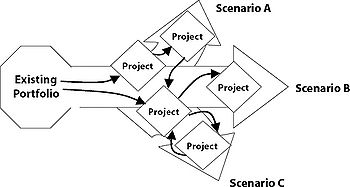
Keeping up with the rapid evolution of technology, the political and social changes and the general unstable business environment, enables scenario planning as an inseparable tool in strategic management. Potentials has also been identified in its application in Project, Program and Portfolio management. More specifically, it significantly improves the way that a wide range of business problems are addressed in terms of organization [4].The application of scenario planning is not restricted in specific cases. The tool may finds its application as a learning tool or a networking process, utilizing the collective participation from people with different backround with the view not only to challenge strategic paradigms but also to redefine the borders of the organization [7]. Although, it is hard to define the exact circumstances under which the tool should be used, the following broaden conditions can be identified:[8] [4]:
- Creation of a more sustainable long-term strategy
- Decision making under uncertain conditions
- Targeting on innovation reinforcement
- Aligning key stakeholders in support of a shared vision
- Large deviation of opinions regarding decision
- The industry has already affected by an important change or is expected to
- Low quality of strategic thinking
In terms of project portfolio management, scenario planning assists in discerning in which projects should invest and allocate resources fitting to the organization's strategic direction [6]. It can be used as the main strategy of developing portfolios[9]. It is about determining a strategic decision based on wide range of possibilities, exploring innovative and unexpected events and scenarios, making business to think out of the box. In other words, scenario planning in project portfolio management plays the role of the project charter in projects [6]. More specifically, it leads the organization, providing guidance pertinent to its projects and the efficient allocation of time, money and resources on them; this is a way to fulfil the primary objective, investing on projects that are more likely to obtain a competitive advantage for the organization[6].
Scenario planning may be also applicable in project management. First, the principle difference need to be discerned between visions and scenarios. For instance, considering a simple model that from Point A you want to go to Point B choosing the most effective way to do so. The common strategy that is followed, is to create a vision of the future, where Point B represents this vision. Tactical and operational tools then will be utilized to define the plan that is required to achieve Point B; the following table (Table 1) shows the general flow. On the other hand, more than one versions of Point B could be assumed due to the uncertainty of the future. As a result the flow in the project plan will be altered[9].
| General flow | Scenario-based flow |
|---|---|
| (project)leader → vision → strategic decisions → implementation | (project)leader → scenarios → strategic decisions → implementation |
In program or project management, scenario planning could be useful when different scenarios between the team members of even the stakeholders need to be discussed in order to clearly define and reveal all the possible aspects [10]. Three major categories that the tool contributes in projects and programs are, Preparatory Planning, Risk Management and Generation of new ideas [10]. On the contrast, many would argue that since scenario planning strategy to be implemented requires a minimum of five years time horizon, its applications in projects, that usualy their life span is less than that limit, will be limited [9].Additionally, as scenario planning contributes at most in primary decision making about the future, it may prove to be unsuitable when the project plan has already determined and approved. However, as it has already discussed, the key principles can add value and advantages in project, program and portfolio management. By definition, projects are prone to use the more tactical perspectives while programs and portfolio the more strategic aspects [9].
How to use the tools
As it has already mentioned, scenario planning is a strategy that consists of multiple plausible scenarios considering a wide spectrum of possibilities, in order to develop robust strategies. The question is how to start using this process in order to fully exploit its opportunities. The engagement of high level executives is required along with experts, researchers and managers. Diversity of knowledge is a necessity in order to examine scenarios in multiple dimensions. Several approaches have been developed standardizing the steps of the implementation process. However, there is no single recipe that fits in all kind of organizations or industries. A general approach is defined by the following steps [6]:
1.Define the Critical Issue:The first thing that an organization has to identify is the scope and the objectives of study in conjunction with the time frame. The critical issues and decisions should be defined in order to set a clear direction. Issues like the key principles of the organization, the nature of the current and future competition or the main objectives, should be agreed and finilized on this phase. Following that, the organization should identify what is the most importand issue that intends to focus on.
For instance, considering a hypothetical non-profit environmental organization [add ref Mal Warwick] where the time frame is looking three to five years ahead. Their major concern is how the shape of the organization will be after those years and if it will even manage to survive under all these uncertainties until then. A workshop will be made to gather the relevant stakeholders, internal or external executives and people with knowledge in the environmental field, trying to make their concerns more explicit. The executive director raises the question, how the organization is going to be affected if their predictions about the disastrous climate change takes place earlier that what they were expected to [add ref Mal Warwick].
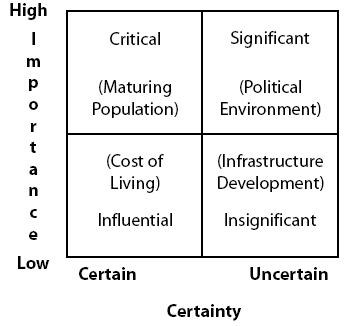
2.Identify Critical Decision Factors:Once the big question for investigation has been identified, the next step is to gather all the information needed for answering it. Utilizing the subject experts, different types of analysis can be consucted like SWOT analysis or PEST Analysis in order to determine the probable influencial factors. In other words, the chosen team has to define the critical uncertainties though a brainstoriming process. The influencies can grouped to facilitate the participants to create and organize the framework effectively. The six most common categories are presented below [6]:
- Internal: are the factors that the organization has complete control. (e.g policies)
- External: are the factors that cannot be controlled by the oraganization. (e.g legislation changes)
- Local: factors that are affected by the local environment only but still have a major importance (e.g local environmental climate changes in the cities where organization's office are located such as hurricane)
- Global: factors that are not regionally restricted (e.g global warming)
- Inevitable Elements: factors that most probable will occur no matter what scenario will be chosen. (e.g environmental changes, population growth, economic, political)
- Critical Uncertainties: factors that are uncertain (e.g people and donors reaction in large environmental changes)
3.Analyze and Rank Decision Factors by Order of Importance and Uncertainty: The identified influencial factors are ranked in terms of importance and impacts for each individual scenario seperately. Figure 7. shows a simple version of a matrix that can be used.
4.Create Scenarios: After accumulating qualitative and quantitative information and determine the most importand drivers, it is time to develop scenarios. A narrative description for each one of them should be made considering that scenarios should be based on creadible information that makes them plausible [PMI]. Scenarios are expected to be different and not just presenting one possible future with small deviations from that [6]. Developing scenarios is a dynamic process which means that scenarios are expected to be continuasly revised and updated during this phase[6].
In the given example, possible scenario could be for instance "What if a hurricane devastates the city during an economic crisis?", is the organizatios prepared to address this scenario?. Three to five scenarios like that will be made investigating and trying to map the possible futures.
5.Identify Implications and Interrelationships of Scenarios After developing the scenarios, the team ensures that the results are in alignment with the critical issues that was identified in Phase 1 [6]. More specifically, it evaluates to what extend the developed scenarios captures the initial question. An analysis takes places for determine possible interrelation of scenarios where other factors may emerge that hasn't taken into consideration before [6].
6.Select Leading Scenario Indicators Monitoring Which Scenario to Implement
7.Implement Strategic Plans The last step, takes places as the scenarios start to unfold while being monitored. The future becomes more certain and the organization is able to discern and execute projects and buisness solutions that are in alignment with the strategic plans[6].
Limitations
The evaluation of scennario planing as a technique is difficult to be consucted. The implementation of the strategic plan based on the selected scenarios requires a lot of time and even more time is needed for the actual impacts on the organization to come to the front. A sufficient tool for evaluating the credibility and accuracy of the results has not been developed and in practise it is mostly used as a tentative tool [2]. Further reaserch need to be made in order to standarize the process of scenario planning and evaluate the outcome. At the moment there are several version and techniques that for companies that are not familiar with the concept seems vague and complicating with no explicit boundaries. Developing succesful and consistant scenarios is a time and resources consuming process [2]. Both the selection of the experts and competend participants demands time and have economic impacts on the organization; taking into consideration that a balance should be preserved in terms of internal and external participant that sufficently represent the organization. Ensuring that the scenarios will be developed under multidimentional discipline conversation and argues is proved to be a challenge. In addition, the collected information from the several sources need to be interperated in the organization's context and framework that again contributes to increasing the required time [2]. A lot of experience and competence requires also create the possible scenarios wihtought ending up with too many or only with the black and white perspective of the issue.
References
- ↑ 1.0 1.1 .The Economist, "Scenario planning". Online article [URL: http://www.economist.com/node/12000755] Retrieved on 15 October 2017
- ↑ 2.0 2.1 2.2 2.3 2.4 2.5 .Mietzner D. & Reger G."Advantages and disadvantages of scenario approaches for strategic foresight",Department of Economics and Social Sciences, University of Potsdam" (2005). [1]
- ↑ 3.0 3.1 3.2 .VLAD GAVRILOVIC, Renaissance Planning "TOWARDS A TYPOLOGY OF SCENARIO PLANNING" Online article http://www.citiesthatwork.com/blog-renaissance/2014/02/towards-a-typology-of-scenario-planning] Retrieved on 21 October 2017
- ↑ 4.0 4.1 4.2 .GBN Global Business Network, Monitor Group "Introduction to Scenario planning" (2008)
- ↑ .Lena Bo¨ rjesona, Mattias Ho¨ jera, Karl-Henrik Dreborgb,Tomas Ekvallc, Go¨ ran Finnvedena. ELSEVIER "Scenario types and techniques: Towards a user’s guide" (2006)
- ↑ 6.00 6.01 6.02 6.03 6.04 6.05 6.06 6.07 6.08 6.09 6.10 6.11 6.12 6.13 6.14 6.15 Dye, L. D. (2002) "Using scenario planning as an aid in project portfolio management" Paper presented at Project Management Institute Annual Seminars & Symposium, San Antonio, TX. Newtown Square, PA: Project Management Institute. [2]
- ↑ Roubelat F. "Scenario Planning as a Networking Process" (1999)
- ↑ Paul J. H. Schoemaker "When and hoe to use scenario planning: a heuristic approach with illustrations" (1991)
- ↑ 9.0 9.1 9.2 9.3 9.4 Craddock, W. T. (2009) "What are the roles of scenario planning in project management?"Paper presented at PMI® Global Congress 2009—EMEA, Amsterdam, North Holland, The Netherlands. Newtown Square, PA: Project Management Institute
- ↑ 10.0 10.1 EPM, Expert Program Management "Scenario Planning and Program Management" Online article: [3] Retrieved on September 22 2019
Annotated bibliography
- 1. Winch, G. M. (2010), "Managing Construction projects". Second edition
- Summary:
